#they’re so Kiki and bouba to me
Explore tagged Tumblr posts
Text
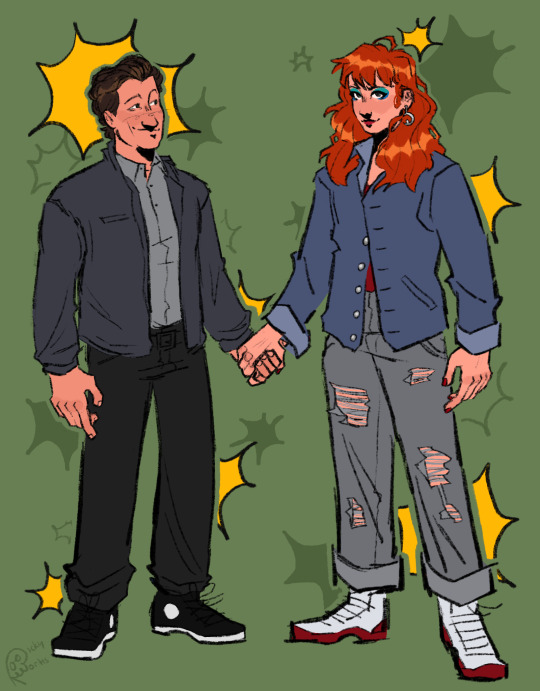
Holloweane… save me…
#holloweane#save me Holloweane#I’m actually going insane about them right now as we speak#so fuckin happy with how this turned out#going through Killer Track for references destroyed me#I forget how heartbreaking the end of it is#RAGHHAGGAH#sorry I just… I love them so much#also fuck yeah t4t Holloweane forever#massive shout out to my guy jetster for introducing me to that#huge#I would die for Duke btw#those heart eyes were made for looking up at his lover#this is true for all curt mega characters#plus also this was my first time drawing a Kim Whalen character#heheheheh#they’re so !!!!!#they’re so Kiki and bouba to me#duke keane#miss holloway#killer track#witch in the web#nightmare time#Curt mega#kim whalen#team starkid#starkid#hatchetfield#my art
738 notes
·
View notes
Note
SO I went through the Project Opal tag and WOW. Great worldbuilding, I can picture it. How do you come up with names and words in the language? I focus on the real world with my writing so not much is left up to me to decide.
I’m glad you asked! Which I’m realizing is a phrase I use a lot!
Loredump time~!
And also
Linguistics time~!
So! The language spoken by people in the Vandeth Desert is called Vandeth. You asked about names and words, so I’ll talk about names and words.
I knew I wanted to use a constructed language (or conlang, for short) for the Vandeth people. After a previous project proved extremely time-consuming and not at all worth it, I decided to create Vandeth using a top-down method. I started by just making up words, then seeing what they had in common, finding rules they follow. Every word I made after that would follow those rules. And when I needed grammar rules, I made those up, and continued following them.
Some of the most important things are vowel inventory, consonant inventory, and phonotactics (what sequences of sounds are allowed to go together). Vandeth uses the standard /a/, /e/, /i/, /o/, and /u/ vowels, and that’s it. (They’re pronounced consistently, unlike in English.) I won’t write out all the consonants, but at this point I’m no longer adding any new ones.
Now, the phonotactics. This is mainly about syllable shapes. In Vandeth, the most common vowel shape is CV. After that is CVC. A very rare syllable shape is VC. Even rarer is CVV and CCVV. I also try to have a good balance of how often certain sounds appear and where. Hard, sharp sounds are more common, while soft, round sounds are rarer. What makes a sound hard, sharp, round, or soft is kinda vague. It’s a bit of a kiki/bouba situation. But to me, a word like “luvimo” doesn’t sound like Vandeth at all, but “shivaki” does.
But how do I even come up with new words? Well, I first look at the words I have and consider if it can be derived from any of those. At one point, I wanted a word for “gossip”. I looked at the words I had, and I noticed blai, “stain” and saksa, a verb stem meaning “to talk”. In Vandeth, words go after the word they describe, and when a word is derived from two others the words swip-swap. So the word for “gossip” ends up being blaisaksa. As another example, the word geital is a combination of gi, “two”, and keital, which used to be “gikeital” before it was shortened to be easier to say. The reason for this is that a geital is the same length as a keital but twice the length. The word keital itself actually comes from the verb stem kei, “to wear”, and the noun tal, “shadow”.
And what about names? Well, usually it’s just a word. Or it should be. I gave a throwaway character (an infant) the name Kimi, which in Vandeth means “pearl”. It’s kind of a cutesy name. Most often I just pick sounds that are Vandeth-y. It’s really important to me that Vandeth names (Vennem, Kalami, Mela) sound distinct from Delgane names (Lynn, Elvi, William, basically any English name) and names from other languages (Sóf, Markhi, Lili).
Don’t even get me started about grammar. There’s lots of linguistics and affixes involved, and admittedly, I haven’t made a whole lot of full sentences so the grammar is actually not super fleshed out. There’s enough for deriving words, though. Maybe I should just start translating random things, or have people send things to be translated via asks. Hmm… Anyway.
#stars. i’m such a nerd#but i love it and i love my work#this is super fun to me and i’m really glad there’s other people who enjoy it#asks#answered asks#cb answering stuff#project opal#lore dump#lore#wip lore#worldbuilding#conlang#constructed language
7 notes
·
View notes
Text
still thinking about how the other day my psychologist asked me if my thoughts had a “tone” and i was so confused by that like they’re just there they don’t have a tone …. but now i realise my thoughts are either bouba or kiki :)
2 notes
·
View notes
Text
ohh okay i see 😭😭 sorry if my confusion was kinda dumb lmao
it’s honestly hard for me to answer any of these because i feel like it’s sorta in between for all of them… Hmm. i will try to answer them now lol
1: sooorta bigger?? Like i don’t make them absolutely massive but i try to keep the snouts somewhat proportionate to their body.
2: depends on what part i’m drawing, necks and tails and sometimes the top of their heads are the fluffiest, as well as the arms, but everywhere else is shorter fur
3: agghhh it depends still!!! 😭 i give them paws and such, but they’re much more cartoony rather than realistic, and i change the proportions from canon slightly (taller, smaller head) so… Shrug
4: HMMM… bouba body and face for sure but he’s got some kiki in there. mainly his boots and sometimes his hat. i draw him with teeth too and Sometimes claws…
thank u for clearing things up!! sorry i am a little bit dumb… it was mainly the first one with the pug-snout and the kiki and bouba one that got me 😭 my brain just decided to be a little too literal with them !!! here is my very ‘literal’ interpretation of “pug-snout moomin” as compensation lol

defining characteristics for a moomin fanartist:
- are snouts full or pug-like - smooth vs category five fluff event - the teddy bear to creature scale - is snufkin kiki or bouba
#mew mews#i feel bad that u had to go thru all that trouble to explain things that now seem super obvious to me LMAOO 😭#sorry again /lh!#maybe my doodle will explain my initial confusion a bit too lol
163 notes
·
View notes
Text
All Things Linguistic - 2021 Highlights
2021 was in many ways a very meta year: most of my writing projects were reflections on the social functions of various other projects I was working on. But those other projects were very interesting both to do and to reflect on, such as coordinating LingComm21: the first International Conference on Linguistics Communication, and redesigning the Lingthusiasm website. (Might they also reflect how under-socialized I got by a certain point in this pandemic? Hmmm.)
I was honoured to be the recipient of the Linguistics, Language, and the Public Award from the Linguistic Society of America in 2021. I put up my acceptance speech as a blog post.
Media and crossovers
How Linguistics Can Help You Learn a Language – I did a talk for Duolingo’s DuoCon
Why do adults…over 40….use ellipses…so much? Crossover with Tim Blais of Acapella Science
xkcd Tower of Babel
Why Shakespeare Could Never Have Been French (video with Tom Scott)
PUZZLE SPOILERS: A quote from Because Internet in the New York Times acrostic
Someone made a crossword puzzle of Because Internet!
Peeking face, palm up, and palm down – the emoji I proposed with Lauren Gawne and Jennifer Daniel are now officially in Unicode 14.0 and will be coming to your devices in the next few years
Media
BBC Word of Mouth – The Shipping Forecast
I’m cited in a Wikipedia article about boomerspeak
I’m quoted in a New York Times Wordplay piece about ending texts with a period.
Lauren Gawne and I did a Lingthusiasm crossover appearance on the NPR show Ask Me Another, featuring two fun quiz segments, one on accepted or rejected emoji and one on famous book titles
Crash Course Linguistics
The final three videos of Crash Course Linguistics came out in 2021, although it was largely a 2020 project. Here’s the full list again so they’re all in once place, or you can watch them all at this playlist.
What is linguistics?
What is a word? Morphology
Syntax 1: Morphosyntax
Syntax 2:
Semantics
Pragmatics
Sociolinguistics
Phonetics 1: Consonants
Phonetics 2: Vowels
Phonology
Psycholinguistics
Language acquisition
Language change and historical linguistics
World Languages
Computational Linguistics
Writing Systems
Each video also comes with a few companion links and exercises from Mutual Intelligibility and a list of all of the languages mentioned in Crash Course Linguistics is here. It was great working with the large teams on that project!
Lingthusiasm
In our fifth year of Lingthusiasm, a podcast that’s enthusiastic about linguistics which I make with Lauren Gawne and our production team, we did some general sprucing up, including a new cover photo (now featuring a jacketless Because Internet), a new portrait drawing, and a new website (for which I wrote a long meta process post here). We also did our first virtual liveshow (as part of LingFest), introduced new bouba/kiki and what the fricative merch, and sent patrons a Lingthusiastic Sticker Pack. Here are the main episodes that came out this year:
Where to get your English etymologies (transcript)
Cool things about scales and implicature (transcript)
Corpus linguistics and consent – Interview with Kat Gupta (transcript)
That’s the kind of episode it’s – Clitics (transcript)
Are you thinking what I’m thinking? Theory of Mind (transcript)
A Fun-Filled Fricative Field Trip (transcript)
Making machines learn Fon and other African languages – Interview with Masakhane (transcript)
Not NOT a negation episode (transcript)
R and R-like sounds – Rhoticity (transcript)
How linguists figure out the grammar of a language (transcript)
Listen to the imperatives episode! (transcript)
Writing is a technology (transcript)
And here are this year’s bonus episodes:
Linguistics puzzles for fun and olympiad glory
Linguistic 〰️✨ i l l u s i o n s ✨〰️
Lingwiki and linguistics on Wikipedia
Q&A with Emily Gref from language museum Planet Word
Sentient plants, proto-internet, and more lingfic about quirky communication
Language under the influence
Gotta test ‘em all – The linguistics of Pokémon names
Lingthusiasm liveshow: The listener talks back (on backchannelling)
Talking to babies and small children
The episode-episode (reduplication)
Conferences and Talks (all virtual unless noted)
Planet Word, the new language museum in Washington DC, about internet language and Because Internet
Slate’s Future Tense about the meaning of emoji with Jennifer Daniel.
I moderated a panel for the European Chapter of the Association for Computational Linguistics (EACL) on NLP Applications for Crisis Management and Emergency Situations.
Contestant on Webster’s War of the Words, a virtual quiz show fundraiser for the Noah Webster House, and also attended online conferences,
guest interview about internet language on That Word Chat (summarized in tweet form)
The Internet is Making English Better at Yale with Claire Bowern
Internet Linguistics and Memes as Internet Folklore with a student at the University of Oklahoma
Sotheby’s Level Up in Los Angeles (physical)
Unicode Conference in the San Francisco Bay Area (physical), where I did a keynote called “Taking Playfulness Seriously – When character sets are used in unexpected ways” (slides here!).
The Unicode talk isn’t online but a few days later I did a talk on the same topic for Bay Area NLP, for which the video is here.
Virtual talk for some internal folks at YouTube
Rosemary Mosco Talks to Gretchen McCulloch about Pigeons, a book event at Argo Bookshop
Conferences/events attended:
Linguistic Society of America (LSA) – did a Wikipedia editathon
American Association for the Advancement of Science (AAAS)
Dictionary Society of North America conference
Annual meeting of the Canadian Linguistics Association
WorldCon (physical)
LingComm and LingFest
In April, I co-organized a pair of new events related to linguistics communication: LingComm21, the first International Conference on Linguistics Communication, and LingFest, a fringe-festival-like program of online linguistics events aimed at a general audience, which contained a total of 12 events attended by a total of over 700 participants. One of those events was our first virtual Lingthusiasm liveshow: here’s a fun thread that I did about backchannels while we were getting ready for the show.
LingComm21 had just under 200 registrants, around 100 of which were formally part of the programming in some way. My opening remarks and closing remarks are here as blog posts, and see the #LingComm21 hashtag for highlights of what people noticed about the conference. We then wrote a 6-part blog post series on the conference as a case study in making online conferences more social, in hopes of helping other people who are interested in better virtual events.
Why virtual conferences are antisocial (but they don’t have to be)
Designing online conferences for building community
Scheduling online conferences for building community
Hosting online conferences for building community
Budgeting online conferences or events
Planning accessible online conferences
Selected tweets
Books and more
A Memory Called Empire and the latest Murderbot novella, Fugitive Telemetry
The Language Lover’s Puzzle Book
History of Swear Words on Netflix
Helpful threads
Analysis of camera angles on tiktok vs youtube (a thread with, unexpectedly, Hank Green)
Generational differences on email salutations, a topic of never-ending public fascination
Threads on conference “homework” and zoom fatigue
Modulo and other obscure English prepositions (a thread)
robot voice in tone languages (short thread)
given that we’ve been living with a giant panda for the past year
Conversation styles
teach students how to email you
Lack of diversity in childhood language acquisition studies
Why kids these days don’t understand file systems
buy your older coworkers a nice linguistics book
A thread about research debt
vocal fry is completely fine
A many-layers-of-screencapped-post citing Because Internet on youth socialization made the front page of Reddit, so I’ve added some further reading
Linguistics fun
Happy feast day of St Gottschalk, patron saint of “languages, linguists, lost vocations, princes, translators”
A thread of linguistics versions of the roses are red meme
Ellipses in vintage recipes
Not Haunted: new favourite example of implicature
Vaccinated every 8 seconds: new favourite example of quantifier scope ambiguity
A bagel with cream cheese: new favourite example of structural ambiguity
In appfreciation opf pfinally being pfurnished with the Pfizer vaccine I will be pfroducing all opf my voiceless bilabial stopfs and pfricatives as apffricates pfor the next pfortnight.
“you may injure…” new favourite example of deontic vs epistemic modality
garden path ads
Linguistics takes on the “for the better, right?” Padme/Anakin meme
lips are a social construct
linguists are really not kidding when they say that your command of language enables you to understand sentences never before said by the human species: bacteria/Michelangelo edition
bouba vs. kiki outfits
tell Duolingo to add IPA
On average linguistics familiarity
linguistic phenomenon reducing capitalization
Zipf’s Law
phonetic boundary ambiguity: chris pratt
linguistics takes on the “did it hurt?” meme
Enweirdening words through AI magic
#MetGala2021 as linguistics books
haunted trunk implicature
emoji reaction research idea
Mario epenthesis
Japan’s new prime minister, Britney Spears crash blossom
red flag on unicode support
linguistics Halloween candy
IPA card catalog
memes and emojis are folklore
Canadian English spellcheck
boō, bōare season
Zoom linguistics studies incoming
linguist puzzles
phonetic beatboxing
is this outfit bouba or kiki
warblish
the feminine urge to make your adjectives agree with your nouns
linguists on a bus
General fun
business larping
Wellerman but in emoji
they taste bland when I fall
A thread of emoji poems
multiocular sideeyes emoji
A thread of linguistics-y place names
French accents and icicles on tiktok
Suez meme: ordinary conversation topics vs noticing something about the language
Convaxulations
A double dactyl about the www
A nice festive machine translation fail
The “CDC says” meme takes on linguistic discrimination
A limerick about my podcast
Dendronization
landline emojis
writing gifs by hand on paper
Hangul children’s book
“left to our own devices”
multi-time-zone days of the week
plamps
srùbag
phonetify wrapped: most used phoneme and zipfy unwrapped
glottal on a bottle
xkcd on relevance implicature: debunking
the linguist urge
Finnish pronouns and sarcasm
teach a person how to look up the etymology of “fish” and they learn for a lifetime
the Double Empathy problem
conjugating Christmas
Christmas plural you form
Pinguinuca and Antipinguinuca
verbing tetris
Grice’s maxim of relevance in photo caption directionality: male bison edition
Selected blog posts
I celebrated my ninth blogiversary on All Things Linguistic! Here are some of my favourite posts from this year:
Linguistics jobs
metadata specialist and genealogist
legislative drafter
technical writer
CEO of a SaaS company
social media lead (for NASA)
senior analyst
academic linguist
Linguistics fun
Linguistics Games online
“Indeed, old man” in Middle Egyptian
Linguistics Halloween jokes
Beatboxing in IPA
The kiki to bouba pipeline
Dinosaur Comics on the “I dunno” hum
Scuba, an exotic English word meaning “to keep breathing even though the water rises all around you”
Self-referential words for places of articulation
Languages
It’s Complicated/Because Internet on why teens socialize online
The fight to save Hawaii sign language from extinction
The art and science of beatboxing
The linguistics of hyperlinks
Pitch, intonation, and the role of technology in language description
The origin of language and interspecies communication
A McGill student and professor realized they both speak Mi’kmaq; it changed everything
ancient translation to badger
Pronouncing words in English (by Chinese speakers)
An interactive visual database for American Sign Language
On standard dialects
Meta and advice posts
Superlinguo’s year in review (involving many joint projects with me and also finally getting tenure!)
I reposted a classic “how to twitter” (from a social perspective) post of mine from 2016, which people tell me they still refer to occasionally
How to get started in writing pop linguistics, both short form (media articles) and long form (books)
How we made a better podcast website for Lingthusiasm
Missed out on previous years? Here are the summary posts from 2013, 2014, 2015, 2016, 2017, 2018, 2019, and 2020. If you’d like to get a much shorter monthly highlights newsletter via email, with all sorts of interesting internet linguistics news, you can sign up for that at gretchenmcc.substack.com.
#linguistics#year in review#roundup#highlights#lists#summary#2021#linkfest#crash course linguistics#lingthusiasm
251 notes
·
View notes
Text
Blog 4: Shapes
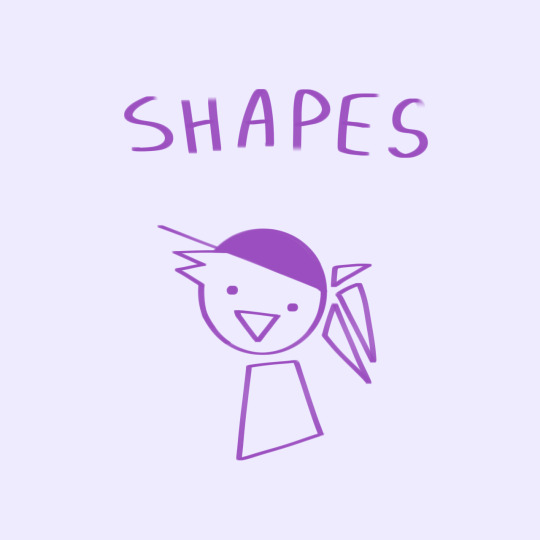
I can confidently say that shapes are one of my FAVORITE things about art! They’re also something very important in art, and with the right understanding, shapes can work very much in your favor!
By definition, a shape is just an outline, a geometric form. However, they often mean more than that! The common thing people learn is that round shapes give a fun, childish vibe. Rectangular shapes have strict, logical, supportive vibes, and triangular shapes are dynamic, energetic. There’s not much rhyme or reason for these vibes other than a bit of psychology and societal influence! However it can be noted that rectangles are associated with sturdy buildings, and circles relate to round, safe toys for children. The Bouba/Kiki Effect is sort of connected to this topic, and it’s something worth reading into, covering how shapes influence speech!
But enough about that, shapes have a history of portraying different emotions, different traits. Although, another reason I love them is for good old simplification! A lot of art is a simplification or alteration of reality, rather than the exact copy. Even then, basic shapes can be used as a foundation to build on top of with more complex structures!
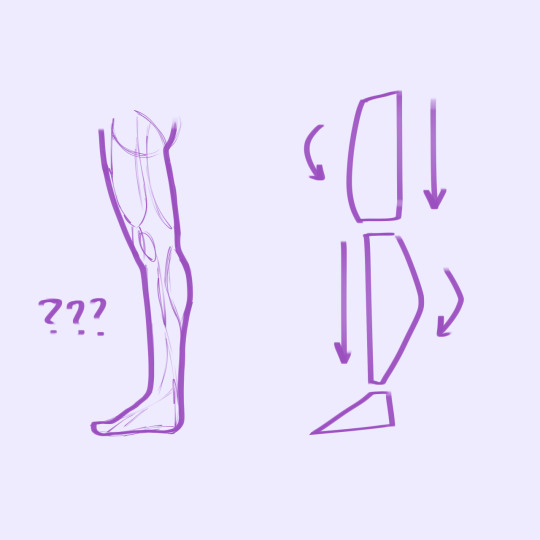
Take this diagram of a leg for example. While the left is definitely more accurate, could you draw it? I could draw it, only by copying a reference, but say you had to draw that same leg in a different position? A unique position, that has no reference at all? That’s where the right leg gets into action. The simplification into basic shapes lets you concentrate on other factors like positioning and dynamics, rather than the accuracy of it all.
Speaking of dynamics-- Have you noticed those arrows? There’s a contrast between the front and back of the thigh, as well as the shin. The thigh is round up front, the shins are round in the back. This, for the most part, follows which area has more muscle leaves the bony side flat. Now, this is far from accurate! The body is rarely perfectly straight, but what this create is contrast, and contrast creates dynamics and energy!
There’s many references for the simplification of body parts, so try to look into those, and create a guide of your own! Many people will structure things with many different shapes, especially when the complexity of their drawings differ, so tell me -or even show- what kind of shapes you use to sketch a body?
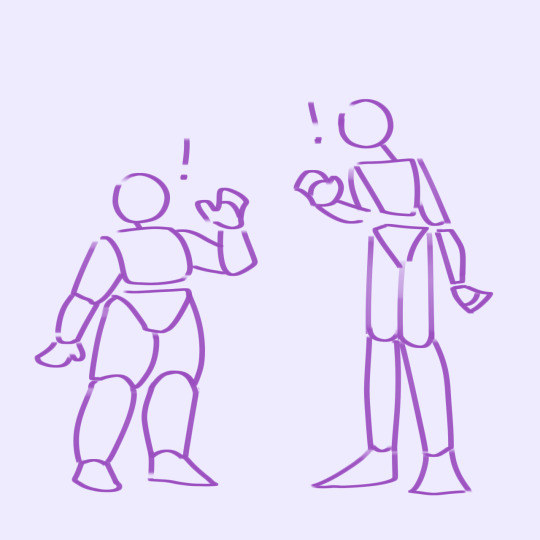
This goes back to the talk about how shapes influence language and emotions. A round, chubby character might give off more cheerful vibes than a tall, lanky one. This isn’t a guarantee, but all sorts of media follow this pattern! Using shapes will give the viewer an idea of who your characters are before they even do anything, as well as adding some diversity to your art! Same Face Syndrome is a common word in the art community, and I believe it isn’t so much of a problem that your characters may look similar, but more that there is an untapped potential in giving them designs that match their personality!
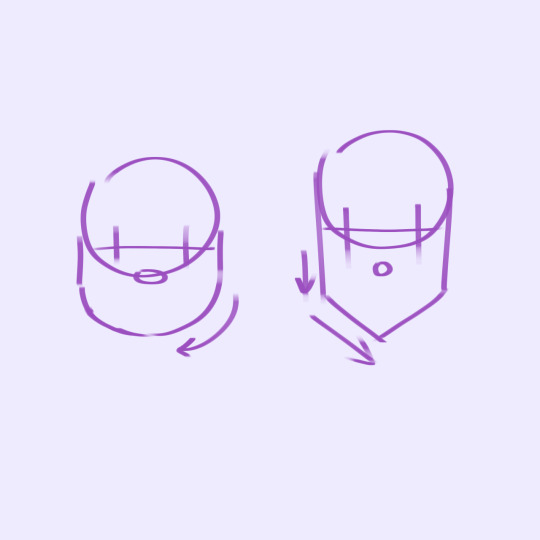
Another example of shapes, used specifically for head shape! Don’t worry if it makes your style feel out of place in some ways though. Sometimes, you’re just going to have to make your style more flexible to encompass a diverse amount of shapes, but you can still preserve something unique in them! Disney is a big user of language in shapes, but look into any 2d animation of your interest! There’s sure to be some usage of shapes if you look for it.
Here, I’ll use a personal example of mine. Take the currently developing psychological horror rpg, Doll Eye! (That’s a mouthful). Doll Eye’s main artist uses shapes to a significant degree, and this can be clearly seen in this main cast, while still preserving a style!
There’s Alfred, the protagonist, as well as a very average, cautious father who only wants a bit of stability. Kao, the support character! Although, he’s mostly known for being a big softie and pacifist, as well as a bit clumsy in his work as a guardian angel. Finally, the antagonist, Dr.Mystery. The use of dynamic, sharp shapes can signal how they provide danger for the main cast, but also that he himself is a morally grey character. There is a striking difference in their shape language, as well as their silhouettes, that shows their personality, rather than having it told for you. Despite this, it’s easy to tell they’re from the same artist. If you wanna, you can dig the internet for some of this artist’s older style, which gave everyone the same body type, same head shape, etc. While cute, it wasn’t nearly as expressive as his current style, and portrays the emotions he wants it to in a much better way!
Got any commentary? Questions? Future blog ideas? Feel free to share them! But until next month, enjoy Thanksgiving!
#art#art blog#artist support#art support#art help#artist help#illustration#art design#artist blog#new artist#doll eye#creativitycentral#creativity central
2 notes
·
View notes
Text
The two 90s Geek Genders were Pagan Fantasy Medieval and Atheist Techie Futurist
Ok so... hear me out.
There was this weird thing - I won’t say it’s as clear as outright male vs female as much as kiki vs bouba. Kiki in this scenario is roughly masculinized (sharp edged and all) and bouba is roughly feminized (soft edged) but in practice it just wasn’t as clear as that.
I experienced geek culture as being *very* gendered, and what’s more is that there was a hidden set of class and culture assumptions undergirding which of those two groups you’d end up in.
Pagan fantasy fan and techie atheist were the two ends of the spectrum in the 90s and it’s weird to realize that a lot of my trying to be pagan when I was in my teens/20s was because of this weird gendered shit and most of it was around this platonic female ideal of female geek. I was trying to perform a higher status female role in my own community; all the popular girls were slender white girls named Willow or Heather or Rowan, who were into musical theater and had long, wavy Disney Princess hair and soft hands with long tapered fingers. (Yes, this archetype is THAT SPECIFIC.) They needed to communicate in ways that indicated that all of their answers came from pure intuition and dreams, extra points if they perform divination of some kind. They couldn’t ever be definitive or “left brained” in their personalities. It was very WASP Femininity only... geeky flavored. WASP by way of Tolkien and Disney instead of WASP by way of idealized domestic figures. Most importantly, they were NOT Jewish. They did not have “Jewish hair.” They did not come up in Jewish households where argument is a love language. They were not loud and did not talk with their hands. They had beliefs about religion and mysticism couched hugely in Christian-style faith even if it was cloaked in pagan aesthetics, and this was upheld as an ideal to perform. (And what’s more is that in “bouba” flavored geek culture, I have actually encountered a lot of casual anti-Semitism, in addition to the aforementioned social pressure to conform to a gentile female ideal. I’ve VERY SELDOM encountered ANYWHERE near the degree of casual anti-Semitism in “kiki” flavored geek culture.) When I’m in spaces where “bouba” is the female ideal, it often feels like I went from there being one normie cis female ideal I couldn’t perform, to finding the same female ideal upheld in a lot of geek spaces and having it be even *harder* to perform. Which is a big reason why I hung out in corners of geek culture that more often were atheist computer types who liked hard sci fi. (The “kiki” nerds.)
But another thing is that *class* is why I was never able to find a place in “bouba” geek culture.
“Bouba” geek culture participation - actual subculture membership beyond being a casual - actually requires participation in hobbies and habits that can become as expensive as, say, being into ski trips and vacations, and one’s status in that setting depends upon how much they’re able to buy in. “Bouba” geek culture is HEAVILY gentrified, and always has been.
“Cyberpunk/computer kid/harder sci fi fan” culture wasn’t as hard to access. If anything, being in those spaces *made* me money instead of *costing* me money.
I *wanted* to be part of many “bouba” geeky things but... I *couldn’t.* Even when I started making enough money to do it, suddenly, I just *didn’t have enough time.* You have to have whole weekends to spare. Once I started making the money, I was spending my free time going to tech conferences, trade shows, etc. The resentment just grew and grew.
I feel like some geek spaces have always been heavily gentrified in ways outsiders don’t parse in the way that people just Don’t See Class. It’s for that reason that I actually don’t support that being the dominant face-forward of geek culture the way it has become.
“We aren’t classist. But you must afford xyz activities and have the free time to do them, to be one of us. Because of your gender.”
It was actually much easier to move in kiki space than bouba space.
#i struggle with being jealous of female boubas tbh#...thinking about how a polycule with a male bouba and a female bouba and a male kiki and a female kiki would map to the 4 Andorian genders#weird shit#I feel like the male kikis still usually wanted bouba partners#my ex husband was trying to cram me into the bouba box#even if it meant becoming someone he didn't get along with because he actually thought poorly of mystical intuitive types#it's like he wanted to be with someone he fundamentally disrespected!! I don't understand WHAT THE FUCK!
27 notes
·
View notes